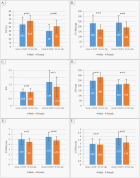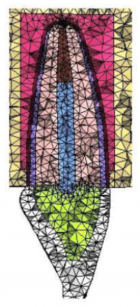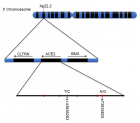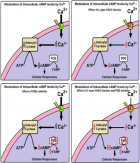Early Online (Volume - 9 | Issue - 1)
Success Rate and Complications of Endoscopic Deacryocystorhinostomy without Stenting: A Retrospective Study
Published on: 16th April, 2025
Endoscopic dacryocystorhinostomy (EDCR) is a well accepted surgical treatment for patients with nasolacrimal duct obstruction (NLDO). Previously, external dacryocystorhino-stomy was considered as the gold standard treatment for NLDO, however, EDCR has gained momentum due to its several advantages. The EDCR has been sounding more aesthetic and as functional compared to the traditional external dacryocystorhinostomy in the surgical treatment of nasolacrimal duct obstruction with comparable outcomes. Purpose: to determine the success rate and complications of endoscopic dacryocystorhinostomy without stenting.Materials and methods: it was a retrospective study performed in the department of Otorhinolaryngology and Head and Neck Surgery (ORL-HNS), Universal College of Medical Sciences-Teaching Hospital (UCMS-TH) from June 2019 to September 2024. A total of 19 patients charts were reviewed. All the cases were performed under general anesthesia. All the cases had undergone without silicon stenting and were regularly followed up for a period of 3 months. Post operative stomal patency and complications were noted based on subjective and endoscopic evaluation.Results: Out of 19 patients, 12 were female and 7 were male with the age range of 12 to 70 years. Transnasal synechiae was seen in 2 female and 1 male patients. Stomal patency was 100% with no recurrence of epiphora in 17 patients (89.4%) during 3 months of follow up. 2 female patients with released synechiae didn’t come for 3 months follow up.Conclusion: It is a safe and minimally invasive procedure and has a comparable success rate to external DCR with an additional advantage of more aesthetic value.
Free Radicals, Antioxidants and Redox Potential
Published on: 29th May, 2025
The role of free radicals and antioxidants is often underestimated despite their involvement in key metabolic processes, although they participate in many important metabolic processes in the life of humans, animals and plants. Their quantity and quality differ from each other, which is not respected. Each cell is attacked approximately 10,000 times by free radicals. Oxidative stress is the cause of many problems, especially in viral diseases. Monitoring of redox potentials in body fluids is usually not carried out. Viral replication is influenced by oxidative energy, derived from either host metabolism or free radical activity, which is supplied by oxidation by free radicals or the host. Nucleic acid mutations due to the effect of free radicals can be the cause of carcinomas, and possible defense against mutations could help eradicate dangerous viruses. The importance of malondialdehyde and antibodies against it is discussed. Eliminating free radicals, reducing lipoperoxidation, and protecting against environmental oxidative stress are important factors for human health.Study objective: To highlight the importance of free radicals, antioxidants and redox potentials for patient diagnosis and therapy.Methods: This study synthesizes findings from multiple published sources, including our own research.Results: Findings highlight the role of free radicals in oxidative stress, DNA damage, and viral replication, with redox potential (ORP) and Malondialdehyde (MDA) identified as key diagnostic markers.Conclusion: Monitoring oxidative balance and targeting free radical activity are essential for preventing cellular damage and improving clinical outcomes in oxidative stress-related diseases.
The Efficacy of Quercetin in Attenuating Oxidative Stress and Clinical Symptoms in Allergic Rhinitis: A Systematic Review
Published on: 26th August, 2025
Background: Allergic rhinitis (AR) affects approximately 10% - 30% of the global population and represents a significant healthcare burden. The condition involves complex inflammatory pathways where oxidative stress plays a crucial role, with malondialdehyde serving as a key biomarker of cellular damage. Quercetin, a naturally occurring flavonoid, demonstrates promising antioxidant and anti-inflammatory properties that may benefit allergic rhinitis management.Methods: We conducted a systematic review following PRISMA 2020 guidelines. Four electronic databases (PubMed, Google Scholar, SagePub, and Semantic Scholar) were searched for studies published between 2000 and 2024. The PICO framework guided study selection, focusing on quercetin intervention in allergic rhinitis models. Both preclinical and clinical studies measuring malondialdehyde levels or clinical symptom improvement were included.Results: Eighteen studies met our inclusion criteria, comprising 14 animal studies and four human clinical trials. Preclinical evidence consistently demonstrated quercetin’s ability to reduce malondialdehyde levels across various tissues, including serum, lung, and liver samples. Human studies showed superior symptom improvement when quercetin-containing supplements were added to standard therapy compared to conventional treatment alone.The primary mechanism involves nuclear factor erythroid 2-related factor 2 pathway activation, enhancing endogenous antioxidant enzyme production.Conclusion: Current evidence supports quercetin’s effectiveness in reducing oxidative stress and improving clinical outcomes in allergic rhinitis through dual antioxidant and anti-inflammatory mechanisms. While most evidence derives from animal studies, quercetin Shows promise as safe adjuvant therapy. Large-scale human clinical trials using high- high-bioavailability formulations are needed to establish standardized clinical protocols.Key messages:• Quercetin consistently reduces oxidative stress markers in allergic rhinitis models.• Clinical symptoms improve significantly when quercetin supplements are added to standard therapy.• The therapeutic mechanism involves both direct antioxidant activity and endogenous defense system enhancement.• High-quality human clinical trials are needed to establish definitive treatment guidelines.

HSPI: We're glad you're here. Please click "create a new Query" if you are a new visitor to our website and need further information from us.
If you are already a member of our network and need to keep track of any developments regarding a question you have already submitted, click "take me to my Query."


















































































































































